Dear Gentle Reader,
This is not for the faint of heart.
This is an older blog post I did on Retro Rack, that I’ve consolidated and moved here. It contains basic guidelines on how to cobble together a pseudo victorian or steampunk outfit via thrift stores.
I originally wrote this post many years ago for a different blog, before I was a paid authorbeast, when I used my online journal as a kind of information distribution center for friends. Back then it was all about thrifting for the Dickens Fair, an icon of the Christmas season up here in NorCal/. I worked there for a decade or so.
I adapted it to be a general Thrifting Victoriana post and it can also be used as a basis for steampunk.
One of my beta readers at Dickens wearing a top (we thrifted) that she made, from a 1980s plaid vest + skirt set (she tailored in the vest and used the skirt for bell sleeves).
I thought I would reboot it one last time for you, my most fashionable of readers. My hope is it will evolve and become a place I can point people too whenever they ask me the inevitable questions, how do I thift for a {fill in the blank} costume.
Outfit made of thrifted velvet bathrobe, white king sized sheet set, tailored 1970’s blouse, straw hat re-purposed to be a bonnet lined with a pleated handkerchief, lots of ribbon.
Anyway, Fashionable Reader, as you may well have guessed I am the shopping denizen for my particular group.
One of my few super powers (including the inexplicable ability to turn off street lights) is thrift store juju. I’ve used it to construct various outfits over the years. You see I have an eye trained to spot the possibilities. So this post was written to help others develop the “eye to what can be”.
Kai modeling a dress I made out of thrifted items: bridesmaid’s cream satin dress, a crochet tablecloth, brown velvet bathrobe, recovered hat, and pheasant feathers from a mask.
Please note:
This is meant to be a basic tips instruction manual to help those just getting into costuming, not for those with more advanced techniques. All rules are made to be broken so please keep in mind that this post is 101, not seminar level. Also I’m not using modifiers for the sake of brevity, all of the instructions bellow are meant as suggestions not commands.
Here we go!
Thrifting for Victorian Inspired Fashion
Some General Thoughts
- Middle to upper-class costumes should FIT properly. You don’t need to sew but you will need to tailor.
- For ladies this means bodice (shoulder to waist) hugs the upper body, blouse sleeves end at the wrists, and skirts show no ankle.
- For men this means the jacket fits the upper torso (shoulder to waist), sleeves are long and do not ride-up, waistcoats are tight to the body, and trousers start at the WAIST and end at top of the shoe, below the ankle.
- Patterned fabric is your friend. Avoid those that look too modern or too machined, go for small checked, striped, tweed, and flowered.
TIP: Look for something you might see on old-fashioned wallpaper.

1860s check dress, Image from my personal collection, please re-post with attribution. ©GAILCARRIEGRLLC
- Color is your friend. The Victorians loved color. Take advantage of: white, black, pastel, jewel tones, primary, secondary, and contrasting. Colors project images. For example: pastels and whites tended to be worn by unmarried young ladies, blacks and reds by matrons.
- For men, early in in the era, yellow and red suggest dandy, and blue is associated with the Corinthian set.
- Women tend to be more matched. A combination of three colors was considered flattering early on in the Victorian era, for example, sage green, peach, and black, by the 1870’s graduating shades of the same color came into vogue. The exception is blouses, worn underneath rest of the outfit, these are almost always white or cream.
- Fabric is NOT your friend. This is England post regency, light fabrics were considered a tad old fashioned, although they did appear. Best to avoid cheep silk, muslin, other light cottons, and, of coarse, anything man-made. Brocade was rare on women, although some men did do it for a waistcoat.
TIP: Opt for twilled raw silks, wool, dupioni, heavy cotton, satin, velvet, taffeta, and other rich, lux, weighty fabrics. Think curtains in libraries.
GOOD MOVIES TO COSTUME WATCH
Nicholas Nickleby – for early lower class.
Washington Square – w/ Jennifer Jason Lee, CHECK OUT HER HAIR!
Jane Eyre (A&E) – good lower-class dresses.
Mrs. Brown – for an excellent range in space and class.
Impromptu – great men’s attire
North and South – not only good costumes but a great romance, and a killer look at the dark side of life and rise of industrialism during this era.
All About Steampunk Fashion
Part ONE: Victorian Dress Thrifting for Women
 |
|
Swiss Waist, Image from my personal collection, please re-post with attribution. ©GAILCARRIEGRLLC |
You have more choices, but more modifications and sewing.
OUTER GARMENTS
1. Hats
Victorian women always wear their hair up. Only whores and very young girls wear their hair loose. In the streets and when visiting or shopping, hair is also always covered, with any of the following:
A. Mob Cap (or Mop Cap): Made of lace or cotton trimmed with lace, usually white, this hat looks like a shower cap with a ruffle around the edge. Favored by older, married women, and widows.
B. A Floof (or Lace Cap): A lace head covering that drapes over crown of head with ruffles in the back and flaps over the ears. Works both inside and outside the house. Can’t be found in thrift stores, but relatively easy to make.
C. Flat Straw (or Shepherdess Cap): A very shallow crown, very wide brim, close weave straw hat that must be held on with hatpin or bow and curved in interesting ways. Favored by younger women and the country set.
The cream and brown hat I made, mainly with a hot glue gun for my 1878 walking gown.
D. Lady’s Bowler: Shaped like a bowler with a slightly smaller brim, made of straw, and worn tilted to one side affixed with a hatpin. Difficult to find.
E. Riding Hat: A lady’s top-hat, this is usually shorter than a man’s, decorated with a vale, and worn with a riding habit. Considered very daring.
F. Perch: An undersized, highly decorated hat with a narrow brim curled up on each side and peaked in the front (like a cowboy hat), worn perched far forward on the head, or far to the back later on in history, and affixed with a hatpin.
Mine is made from a fez with a turned up back brim. Feathers from an African mask, and dried flowers.
G. Bonnet: Sits way back on the head, highly decorated to match the dress.
H. A whole range and variety came in the 1870’s that emulated turbans and flowerpots like the toque.
I. And in the mid to late 1970s the teeny tiny hats came in as well. You can make on of these using a doll’s hat blank from any craft store.
The crazy purple Ivy hat I made using a bucram blank, a Styrofoam flowerpot insert, a glue gun, and lots of scraps.
THRIFTERS: Bonnets and flat straw hats can be made by cutting down regular straw hats. Look for close weave, bendable straw of any color with a shallow crown. All of the above tended to be highly decorated with silk flower, fake fruit, feather birds and more. Millinery is lots of fun, especially with a glue gun!
2. Shawls
Large square or triangle shape of heavy silk usually embroidered. NO CUT-VELVET! Cape is another good option.
Tip: Christmas tree skirts work really well as cape-like jackets.
Here is one I picked up from an after Christmas sale at TJ Max used as a shawl, and also as a can can skirt for a steampunk outfit.
3. Vest
You can, as a shop-keep, get way with a woman’s vest instead of jacket (vests are also worn under bolero style jackets). Vests should have no pockets, be VERY fitted, button or clasp up the front, have a full back (none of the fake liner fabric), flare at the waist, and have wide sloping shoulders. You will need a shawl to go into the streets. Swiss waists are also an option.
THRIFTERS: Look for full (no synthetic back), fitted vests with darts.
4. Blouses
Usually white/cream and designed to show only at the wrists and neck, blouses tend to be pretty masculine in cut and look, although they should be fitted to the torso. They usually have little lace collars, and full sleeves to a tight band of lace at the wrists. Shoulders are sloped. Necklines are high and round or v-shaped (with or without a turn-down collar), or mock turtle style, all with lace at the edge. Blouses can have some shirtfront detailing or lace, but NOT a tuxedo ruffle.
THRIFTERS: Avoid sleeves that puff out from the shoulder, are ruffled at the shoulder, and anything that turns the silhouette square (unless, of coarse this will be covered over by the rest of the outfit). Look in the white blouse section of thrift stores, you should find something. Remember you can go very masculine and wear a little necktie or lady’s cravat.
5. Jacket
You have many different style choices but only three are likely to turn up when thrifting. All the following jacket’s sleeves are full bell-shaped, although some have the fullest part at the elbow and taper in at the wrist.
A. Bolero: If your blouse is fitted, or you have a vest, you can wear a bolero style jacket. These usually end just below the breast, have one clasp or are held closed with a broach, and taper back with a curved line.
Jacket made from a shirt I reversed, slit up the front, pealed back and sewed ruffle on edge.
B. Regular: A tight single-breasted jacket, with or without a collar, fitted to the waist in a peak then flaring out as basques, slight tails, or a deep pointed front.
C. Blazer: Usually only worn by very poor women, they resemble modern men’s suit jackets, are usually velvet and darted to fit tight at the waist.
THRIFTERS: Look for close fitting, single-breasted jackets with NO SHOULDER PADS and wide sleeves, velvet blazers, bathrobes of good material, and the top half of dresses that can be cut off.
6. Skirt
The easiest part to find and to make from scratch, skirts are very full, gored, and run from pleats to ruffles to roushes to swags to ribbons. They changed in general silhouette over the years, from full crinoline to bustle to natural form, but always had a lot of fabric.
THRIFTERS: Look for a full skirt that has a waistband (rather than elastic) and can fit over several underskirts or a crinoline. It doesn’t have to be floor length, you can always add ruffles to the bottom. Wedding dresses can often be cut apart and ribbon added. Check the LINEN SECTION as skirts can be made from curtains or sheets. Dust-ruffles for beds make great readymade ruffles.
7. Shoes
A. Ankle Boots: Should hit just below, just above, or several inches above the ankle and lace up the front or (better!) up the side, with a flat sole or low hourglass heal. Boots can be made of leather or canvas in any color with a natural toe shape. The difficulty is in finding them without zippers. Consider substituting ribbon for laces.
B. Dancing Slippers: Ballet flats with a round toe made of satin or leather in any color that can ribbon tie up the ankle (but don’t have to).
UNDERPINNINGS
8. Chemise (optional)
A fitted undershirt worn beneath the corset, with a low square or scooped neckline and capped sleeves, made of a very light material. You do not need one unless you have a corset.
9. Corset
They are nice because they make your posture Victorian and your clothing hang correctly. Either invest in a cheap stretchy one (under $50) or buy the real thing ($150 – 500), don’t go halfway, nothing in the world is worse than an ill-fitting corset.
7 Tips on How to Buy a Corset That Fits from Gail Carriger
10. Petticoat
Originally a petticoat was a kind of chemise with a skirt attached to the bottom that falls to just below the knee. You do not need one unless you have a corset or a scratchy underskirt.
11. Underskirts
Often wrongly called petticoats, real Victorian underskirts are worn over the crinoline (to disguise the hoops) or (by the lower-classes) instead of a crinoline, often they were stiffened to ensure the overskirt flowed properly. The “substitute crinoline” was usually made of compressed, starched horsehair, very stiff and VERY scratchy, with a pretty fabric ruffle at the bottom. You can cheat by using modern “petticoats,” the kind made to go under wedding dresses (but you’ll probably want to add a cotton or lace ruffle to the nylon in case it is seen). The Victorians were fond of outrageous underpinnings. Demurely clad young ladies often wore bright red underskirts, teal bloomers, and so forth.
THRIFTERS: Look for petticoats made for wedding dresses and/or stiff taffeta skirts. You can always wear more than one.
11. Crinoline (optional)
Known by us laymen as “the hoopskirt,” you probably won’t find a crinoline thrifting, though they do turn up with wedding dresses occasionally. You can buy the cheep nylon kind for $30 from a dance supply store, or sometimes secondhand for less from a costume shop. Think carefully about whether you want to spend the money, crinolines can be very annoying to store and clean.
12. Under Drawers
Under drawers are not optional. You have two choices, both VERY easy to make. Both styles can be made from plain wide-legged, baggy women’s slacks in cotton, silk, or satin fabrics. In Victorian times both styles were split at the crotch, so you didn’t have to unlace your corset to use the loo. You don’t have to go that far unless you wear a corset. I just wear mine elastic at the hip, below my corset.
A. Bloomers: Baggy breaches, which end just below the knee in a wide, fat, lacy ruffle. (Originally called ‘pantaloons’ the actual bloomer was designed as outerwear – too shocking!)
B. Pantalettes: Traditionally worn by young girls in the nursery, pantalettes briefly made an appearance as an adult garment in 1853 and were considered quite scandalous as they could be (gasp!) SEEN when a lady lifted her skirts. They are longer than bloomers and taper slightly, to end at the ankle, again with lots of lace at the bottom.
THRIFTERS: Look in women’s pants section for wide, white, drawstring slacks.
13. Stockings
White, knee-high or over-the-knee socks in a natural looking fabric. Target has them.
ACCESSORIES (the fun part)
14. Gloves
Short, white (usually kid) gloves were a vital part of any lady’s wardrobe, but you can use a color that matches your outfit. Your options also include: lace and net, fingered, finger-less, and gauntlet styles.
15. Parasol
My favorite, the parasol has a glorious history, it was one of the most significant gifts a man could give his intended. The shades were smaller than those you can find today, almost doll like, coming in a variety of sizes with very long handles turning them, by 1880 into a kind of walking stick. By about that same time a lady of quality had a parasol to match every daytime outfit.
16. Belt
More like waist cinchers, lady’s belts are wide and stiffened with boning usually made of a dark, contrasting color or matched to the fabric of the dress. They are either peaked at bottom front (and sometimes also top – called a Swiss Waist) and fastened behind, or sash-like and tied in a wide trailing bow down the back of the skirt.
17. Reticule
The Victorian purse, this item matches the dress and comes in a wide variety of shapes and styles. A simple reticule is very easy to make from extra material and trim.
18. Basket
A good alternative to the reticule, Victorian baskets are carried by lower and middle-class women. They are usually made in a closer weave and smaller size than Ren Faire baskets. They can be lined in fabric and decorated with lace and ribbon.
19. Jewelry
Victorians love jewelry and a lady of any class always wears some, even if it is all she has. Such jewelry includes: hatpins, hairpins and clasps, earrings (yes, pierced), broaches, scarf clasps, necklaces, bracelets, and rings.
THRIFTERS: Look for subtle, delicate costume jewelry including or combining: pearls, crosses, cameos, lockets, old-fashion paste gems, filigree (metal fashioned to look like lace), set in or made from silver, gold, or both.
20. Decoration
Think in terms of excess where decoration is concerned. Load your outfit down with ruffles, ribbons, lace, tassels, fringe, beads, embroidery, fake flowers, and feathers. Once you have a color scheme I advise buying at least 10 yards of one nice ribbon to use to decorate and tie the entire outfit together.
TIP: Expect to spend good money on trim (unless you have a stock or hit a really good church bizarre). It is worth it because it makes all the difference.
Don’t be afraid of WHITE.
How to Remove Odors From Hand-Me-Down Clothes
SHORTLIST
Women, when you walk into a thrift store you should zero-in on these sections:
- Hats
- Shawls
- Women’s White Blouses
- Women’s Vests
- Women’s Jackets = bolero, blazer
- Women’s Skirts = long, full
- Dresses = use top part as a jacket, or the bottom part as a skirt
- Bathrobes = jacket
- Wedding Dresses = underskirts or skirts
- Women’s Shoes
- Women’s Pants = wide leg slacks for bloomers
- Linen’s Section = bed ruffles and curtains
Part Two: Victorian Dress Thrifting for Men
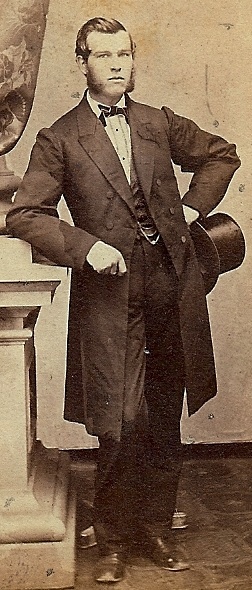 |
| Most Likely American, c. 1860s. Image from my personal collection, please re-post with attribution. ©GAILCARRIEGRLLC |
1. Hat
This is the most expensive item. Top-hats were the most common, which can be short (daytime, races, driving, visiting clubs) or tall (evening, formal events, weddings, funerals), and any color (black and gray are most common). Alternatives include bowlers and trilbies (newsboy cap). Men wore hats, always, period, end of story. Hats rarely turn up in thrift stores, except trilbies. Top-hats are cheapest online, expect to spend around $75.
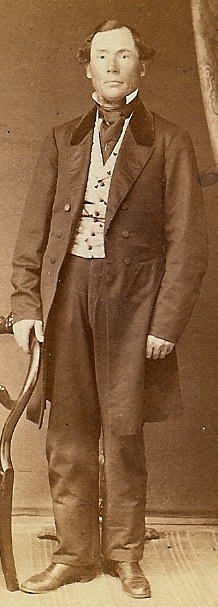 |
| Most Likely American, c. 1860s. Image from my personal collection, please re-post with attribution. ©GAILCARRIEGRLLC |
2. Cravat
A cravat is a length of colorful lightweight fabric tied around the neck (often silk or satin). Usually no pattern. Modern ties do NOT work. The longer a cravat, the more elaborate the knot. No velvet and no wool. (Upper-class evening dress required at least 3 yards of white Egyptian cotton, called “lawn.”) A black ribbon might be tied over a cravat for formal occasions.
TIP: A cravat should be AT LEAST as long as your arm and as wide as your splayed hand.
THRIFTERS: Look for colorful women’s scarves, sashes, and fabric from which a long strip can be cut.
3. Shirt
The Victorian mens shirt is basically a plain, white men’s dress shirt (no stripes, no ruffles) with full sleeves and no turned collar (though this isn’t vital). (Upper-class collars were squared and stuck straight up, a stiff independent piece was inserted under the cravat.)
THRIFTERS: If you can’t find this part of your costume, you’re hopeless. Just tinker with the collar a bit.
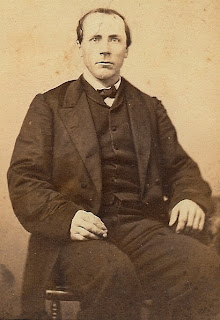 |
| Most Likely American, c. 1860s. Image from my personal collection, please re-post with attribution. |
4. Waistcoat
The modern men’s vest with the peaked bottom front, deep v-neck, and synthetic tied back is not Victorian. A waistcoat should end about two inches below the natural waist-line and be squared off at the bottom (easy to hem from pointed or too long). The v-neck ended at the sternum, though it can go higher and/or fold over in a curve (the shawl collar). Waistcoats should be made completely (front and back) from the same fabric and be colored and/or patterned: think red, yellow, green. They can be double or single-breasted, single is more flattering to most men.
(Purely syntax: around the middle of the Victorian era vest came to mean single breasted, while waistcoat meant double breasted.)
THRIFTERS: Look in WOMEN’S VESTS for waistcoats with the same fabric all the way around, and no pockets (or one small one near the waist). Although for steampunk you can always embellish the pocket. You can also think in terms of sleeve removal. If you can find a thin jacket or robe from which the sleeves can be taken? Those brocade cropped monstrosities from the 80s can have a whole new life.
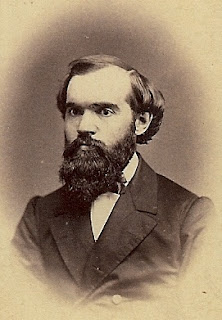 |
| Most Likely American, c. 1860s. Image from my personal collection, please re-post with attribution. ©GAILCARRIEGRLLC |
5. Jacket
The jacket is one of the hardest things to find: should have tails and be fitted through the torso. It can be single or double-breasted. Tails that fit properly end at the back of the knee. 3 options:
| Still from the BBC Mini Series, Cranford |
A. Tuxedo-tails (evening dress):
Modern styles work fine, but make sure to AVOID the satin stripe along the seam (AKA the tuxedo stripe) and anything too pointed.
B. Swallow-tails (or morning coat):
Not cut-away square like tuxedo-tails, but forms tails by graduating down from front to back. (Man in the photo of the couple at the beginning is wearing a swallow tail.)
C. Frock-coat (or skirted jacket):
Basically tails without any cut away or graduation at all, they fit to the waist and then flair out. This style looks the most period and is the hardest to find. Unless you convert a woman’s coat.
THRIFTERS: Look for long coats or jackets that can be cut down. Women’s coats work great but often don’t fit through arms and shoulders. Expect to spend $75 on a quality pair of tails.
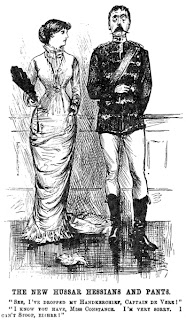 |
| Image from my personal collection, please re-post with attribution. |
6. Trousers
Plaid, striped, checked, formal, and tweed all work. Trousers must fit all the way from natural waist to top of foot with a slightly tapered leg. No Belts.
THRIFTERS: You should have good luck if you look in WOMEN’S SLACKS (watch out for too-light weight fabrics).
7. Socks
Modern dress socks that match the shoes are fine.
8. Shoes
Nice men’s dress shoes in black or brown will work OK, spectator and wingtips came in during the later half of the Victorian era but were considered very, very daring.
THRIFTERS: Look for men’s dancing or formal shoes, very plain.
9. Accessories
A. Scarf: Long, straight wool or silk scarves (the same length as cravats) with a small fringe were worn draped around the neck. (Silk ones are called opera scarves.)
B. Cravat Pin: A small, jeweled pin fastens your cravat (just below or inside the knot) to your shirt. Usually the same kind of design as a woman’s hatpin, such as a single pearl, or an emerald set in gold – only shorter in the stick part.
C. Pocket Watch
D. Pipe
E. Suspenders: Since most did not wear a belt, almost all Victorian men wear suspenders to keep their trousers up. But as suspenders reside under the vest no one knows if they are there but you.
F. Spats or Gaiters (knee-high spats):
Spats and gaiters can be found on line or at your local military surplus stores. Gaiters (the long version of spats) are difficult to find in tend to indicate country “Squire.”
G. Gloves: Should be white or gray, kid leather (practically impossible to find) or cotton.
H. Buttons: All plastic buttons should be replaced with metal or cloth-covered ones.
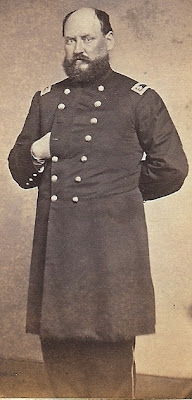 |
| Most Likely American, c. 1860s. Image from my personal collection, please re-post with attribution. ©GAILCARRIEGRLLC |
10. Overcoat (optional)
Three options, all made from either wool or canvas.
A. Trench Coat: A double-breasted coat that falls at least to mid-calf.
B. Duster: A floor-length, single-breasted coat fitted through the waist (think matrix).
C. Great Coat: Cut like either of the above but with one, two, or three capes attached over the shoulders.
SHORTLIST
Men (or Madame Lefoux), when you walk into a thrift store you should zero-in on these sections
- Women’s Scarves = cravat or scarf
- Men’s Shirts = white dress shirt
- Women’s Vests = waistcoat
- Women’s Coats = jacket to make into tails
- Men’s Jackets = tails
- Women’s Slacks = trousers
- Men’s Shoes = dress shoes
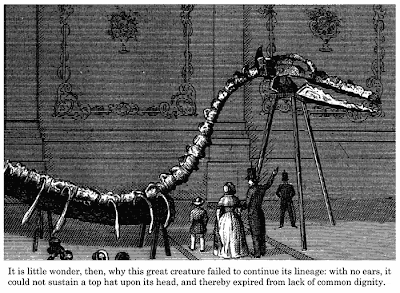 |
| Meme via FB |
Congratz for wading through such a massive post!
Feel free to comment with your own tips and tricks! Also this post is a bit old so some of this may be out of date.
Yours (currently getting RID of costuming),
Miss Gail
- Want to know why I’m getting rid of stuff, I tell the Chirrup my secrets, because I love them bestest. Sign up here.
- Not into newsletters? Get only new releases by following Gail on Amazon or BookBub!
- Coop de Book for October 2019 is Bloodlust & Bonnets by Emily McGovern (comic). I bit spendy but it will make a GREAT Christmas gift.
OUT NOW!
Reticence: The forth and final Custard Protocol Book!
USA & Canada: Amazon print & digital & audiobook | Kobo | B & N | Apple | Audible | Other
UK digital & print | Kobo | Apple UK coming soon I hope
Bookish and proper Percival Tunstell finds himself out of his depth when floating cities, spirited plumbing, and soggy biscuits collide in this delightful conclusion to New York Times bestselling author Gail Carriger’s Custard Protocol series.
GAIL’S DAILY DOSE
Your Infusion of Cute . . .
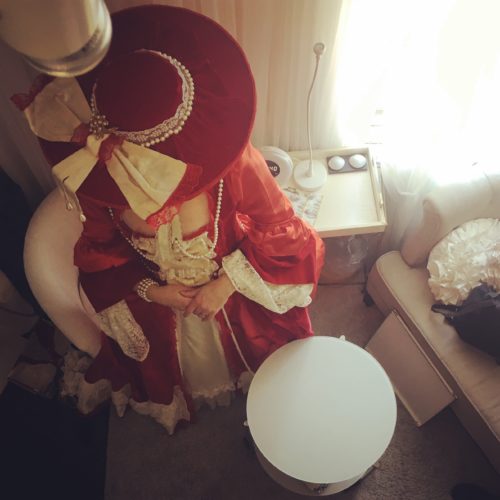
In my red & cream rococo outfit, also thrifted combo of two robes, 2 prom dresses, 2lace skirts, and a lot of trim.
Your Tisane of Smart . . .
Inside a Victorian Bathing Machine
Your Writerly Tinctures . . .
Do Writers Know Too Much To Enjoy Reading?
Book News:
It’s not an interview but you can listen to a fellow fan wax poetical on your truly on the Underrated Podcast: It’s pronounced Grrrrr
Quote of the Day:
“The only way to atone for being occasionally a little over-dressed is by being always absolutely over-educated.”
~ Oscar Wilde

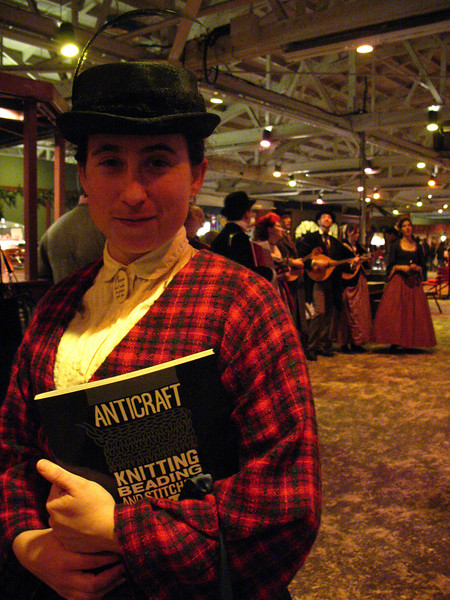





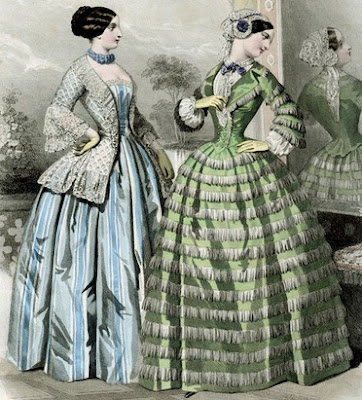


















A riding hat with a ~vale~?
“Oh, look! There is a nit! I must pick it!”
Shoot! and I really mean Shoot! I was just about to donate my 1995 Princess-with-a-big-ass-silk-skirt-and-bow wedding dress to Goodwill. And now I feel that I. MUST. KEEP. IT. FOR. REFASHIONING. Shoot!
My bad?
I feel you, but mine was “church bizarre” instead of “church bazaar”… And by one of my favorite authors, no less! Lol